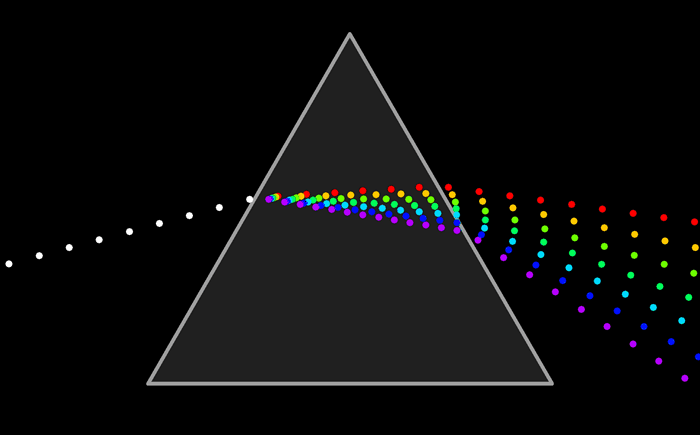File:Light dispersion conceptual.gif
Light_dispersion_conceptual.gif (༧༠༠ × ༤༣༥ བརྙན་རྒྱུ།, ཡིག་ཆ་ཆེ་ཆུང།: ༡༡༩ KB, རྣམ་གཞག།: image/gif, looped, ༨ frames, ༠.༨ s)
ཡིག་ཆའི་ལོ་རྒྱུས།
ཟླ་ཚེས་/དུས་ཚོད་གནུན་ཏེ་རྩོམ་ཡིག་ལ་ལྟ་བ།
| ཚེས་གྲངས། / དུས་ཚོད། | བསྡུས་དོན། | ཚད། | སྤྱོད་མི། | བསམ་ཚུལ། | |
|---|---|---|---|---|---|
| ད་ལྟ། | ༡༧:༢༨, ༢༤ ཟླ་གཉིས་པ། ༢༠༠༧ |  | ༧༠༠ × ༤༣༥ (༡༡༩ KB) | LucasVB | Changing "white photons" back to the same size as the colored ones. |
| ༡༧:༣༢, ༡ ཟླ་གཉིས་པ། ༢༠༠༧ |  | ༧༥༠ × ༤༩༨ (༡༡༧ KB) | Leyo | Auf eine alte Version zurückgesetzt | |
| ༡༡:༣༩, ༢༣ ཟླ་དང་པོ། ༢༠༠༧ |  | ༧༥༠ × ༤༩༨ (༡༡༧ KB) | LucasVB | Larger "white" photons may give a better idea of "division of white light". Also, removed magenta color since it is not a spectral color (I don't know why I didn't do this earlier) | |
| ༡༦:༥༤, ༢༡ ཟླ་དང་པོ། ༢༠༠༧ |  | ༧༠༠ × ༤༣༥ (༡༢༡ KB) | LucasVB | Once again, larger (700px), but now a constant stream of "photons", per request. The file is actually smaller now because we just need 8 frames. | |
| ༠༥:༠༡, ༢༡ ཟླ་དང་པོ། ༢༠༠༧ |  | ༤༥༠ × ༢༩༦ (༣༧༩ KB) | LucasVB | Larger size. | |
| ༢༠:༥༢, ༢༠ ཟླ་དང་པོ། ༢༠༠༧ |  | ༢༥༠ × ༡༦༧ (༢༦༥ KB) | LucasVB | Conceptual animation of w:dispersion of light. |
ཡིག་ཆ་བེད་སྤྱོད་ཁུལ།
pagelinks འདི་ལ་སྦྲེལ་ཡོད།
Global file usage
The following other wikis use this file:
- Usage on ar.wikipedia.org
- الكندي
- ضوء
- انكسار (فيزياء)
- غاليليو غاليلي
- تجربة ميكلسون ومورلي
- ازدواجية موجة جسيم
- بوابة:الفيزياء
- ضوء متباطيء
- مقراب
- فوتون
- ليزر
- طيف كهرومغناطيسي
- تجربة الشق المزدوج
- أثر بوكل
- ظاهرة كير
- لون
- موجة كهرومغناطيسية
- إسحاق نيوتن
- قوس قزح
- تدوير ضوئي
- مقياس استقطاب
- منشور نيكول
- علاقة كراميرس-كرونيج
- دليل موجة
- طول الموجة
- نظارة
- تشتت (بصريات)
- جيمس كليرك ماكسويل
- تأثير دوبلر
- ألبرت ميكلسون
- سرعة الضوء
- رينيه ديكارت
- نظارة طبية
- عدسات لاصقة
- ليف بصري
- المناظر
- بصريات
- هنري بيكريل
- بوابة:الفيزياء/بوابات شقيقة
- ظاهرة كهروضوئية
- تخزين بيانات بصرية ثلاثية الأبعاد
- عدسة (بصريات)
- سراب
- قانون بير-لامبرت
- مطيافية
- آندرز أنغستروم
- قنديلة
- لويس دي بروي
- استقطاب (فيزياء)
- إرنست كارل آبي
View more global usage of this file.

